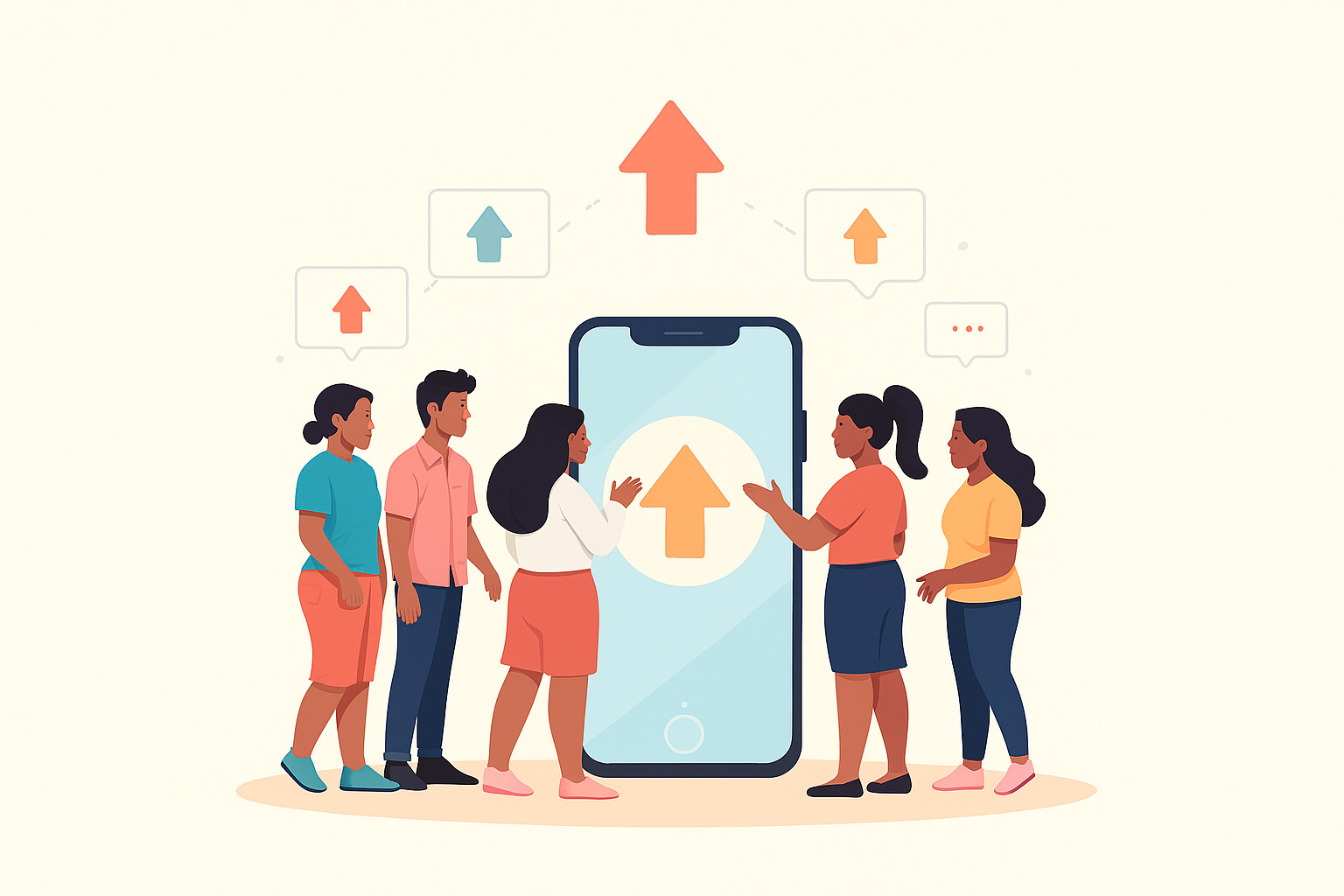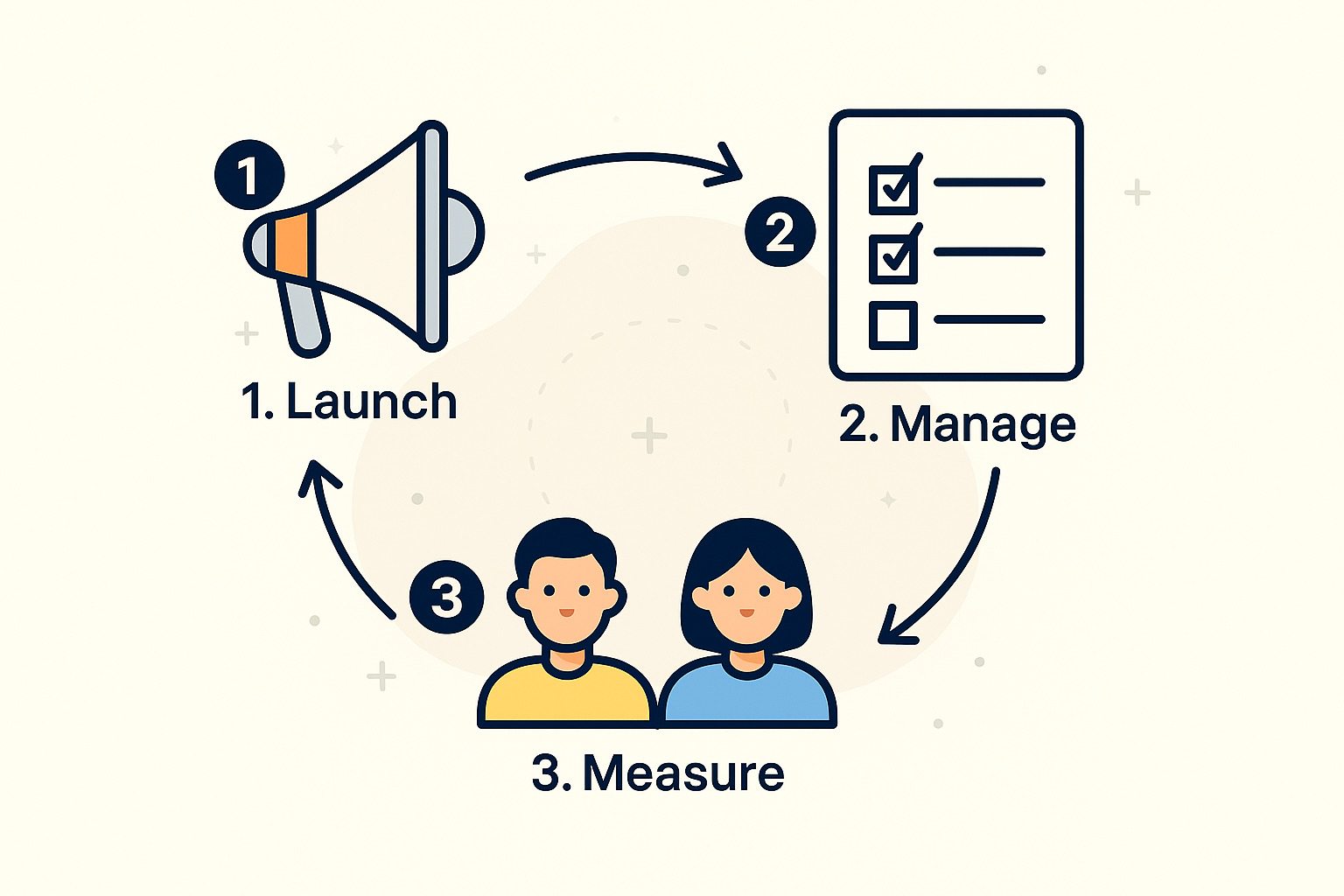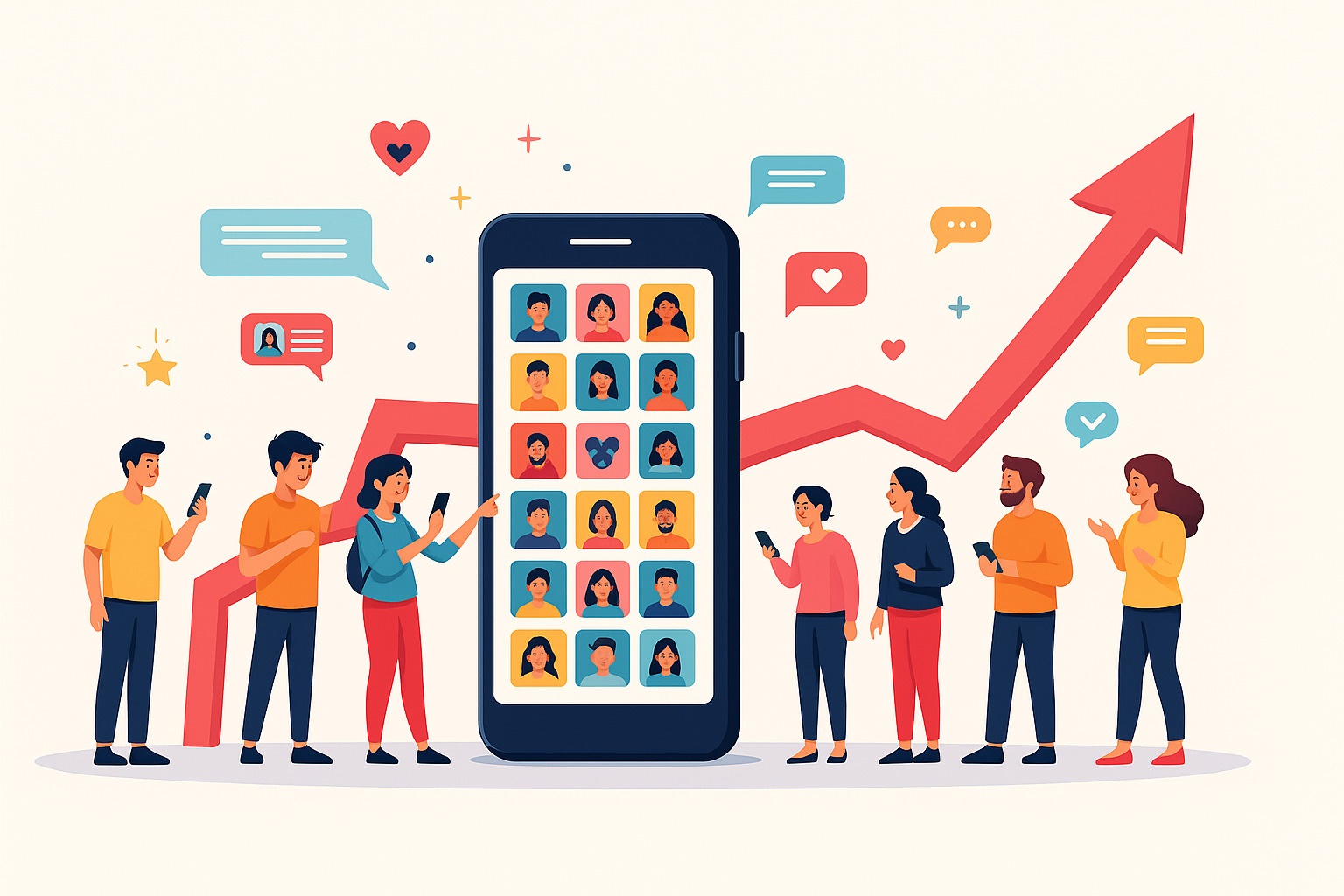Instead of just broadcasting your own message, what if you could get your audience to tell your story for you? This is the power of user-generated content (UGC) campaigns. You tap into authentic, peer-to-peer endorsements from the people experiencing your products and corporate events firsthand. It builds a level of trust that traditional marketing simply cannot buy.
What Are User-Generated Content Campaigns?

UGC campaigns turn your customers and event attendees into active storytellers. Think of it as a creative partnership. You provide the prompt and the platform, and your community runs with it, creating genuine, relatable content that amplifies your message far beyond your own channels.
This approach is a game-changer for corporate events like trade shows, conferences, product launches, and employee engagement campaigns. An attendee sharing a photo from your trade show booth or a video testimonial about your new software is infinitely more persuasive to their network than another polished corporate post.
The Power of Authentic Voices
The move toward UGC is not just a trend; it is a fundamental shift in marketing strategy. Today, a staggering 86% of companies incorporate UGC into their marketing mix. The results speak for themselves: campaigns featuring authentic content typically perform around 25% better, and brands see 29% higher web conversions. It is all rooted in a simple truth: people trust other people more than they trust brands.
When someone sees a colleague or industry peer posting about their great experience at your event, it acts as powerful social proof. It is the digital equivalent of a word-of-mouth recommendation, scaled for the masses.
Of course, a major goal here is to expand your brand's digital footprint. There are many proven strategies to boost social media engagement that pair perfectly with a UGC-first mindset.
Let's break down how UGC stacks up against old-school advertising.
AttributeUser-Generated ContentTraditional AdvertisingAuthenticityHigh; seen as genuine peer reviews.Low; often perceived as biased or scripted.TrustBuilds high levels of trust and credibility.Can be met with skepticism from consumers.CostTypically lower cost, often incentivized.High production and media buying costs.EngagementDrives higher engagement and interaction.Often passive; one-way communication.Conversion RateGenerally leads to higher conversion rates.Lower, as it lacks social proof.Content SourceCreated by customers, fans, and attendees.Created in-house or by an ad agency.
The takeaway is clear: while traditional ads have their place, UGC offers a more organic and powerful way to connect with modern audiences who crave authenticity.
How UGC Works at Corporate Events
At a corporate event, a good UGC campaign is more than asking people to post online. It is about designing specific, interactive experiences, or "activations," that make content creation feel natural, fun, and worthwhile.
Here are a few ways this comes to life:
- Interactive Photo Ops: An AI photo booth or a cleverly themed selfie station becomes a natural hub for content creation. These tools give attendees high-quality, branded photos they are genuinely excited to share.
- Contests and Giveaways: Running a contest for the "best photo" or "most creative post" using your event hashtag gives people a clear reason to participate and show off their experience.
- Digital Story Collection: A video testimonial booth or a virtual event microsite are great ways to promote digital story-collecting. They make it easy for attendees to record and submit their thoughts, feedback, or success stories on the spot.
By weaving these elements into your event, you are not just hosting a gathering. You are building a pop-up content studio powered by your most passionate advocates. This creates a powerful cycle where attendee content inspires more attendees to participate, generating buzz that echoes long after the event floor has cleared.
The Strategic Value of UGC for Corporate Events
The goal of any corporate event is to create memorable experiences that tie directly back to business results. User-generated content campaigns are one of the most direct and powerful ways to do exactly that. They take passive attendees at trade shows, product launches, and expos and turn them into your most enthusiastic brand advocates, sparking a ripple effect of authentic promotion.
Instead of just pushing out polished, top-down corporate messaging, you invite your audience to share their own stories. That kind of peer-to-peer validation is fundamentally more trustworthy. When someone posts a photo from your booth or a quick video testimonial, it is powerful, real-time social proof for their entire network.
Extend Your Reach Beyond the Event Floor
One of the biggest wins from a UGC campaign is its power to amplify your event's reach well beyond the venue. The conversation is no longer limited to the four walls of the convention center. Every photo, video, and social post shared by an attendee becomes a digital breadcrumb leading right back to your brand, reaching audiences you might never have touched otherwise.
This kind of visibility is gold for driving qualified traffic to your booth. When prospects see their peers and industry leaders engaging with your brand online, it sparks a bit of FOMO (fear of missing out) and genuine curiosity. They become that much more likely to seek you out on the event floor to see what all the buzz is about.
A well-executed UGC campaign does not just capture moments; it creates momentum. It transforms a one-time physical event into a widespread digital conversation, building brand authority and driving tangible interest long after the doors have closed.
This authentic content becomes a real driver for lead generation. Interactions are no longer just about a quick badge scan. They become meaningful engagements where attendees are actively co-creating your brand’s story right alongside you.
Build a Library of Authentic Marketing Assets
Beyond the immediate buzz, a good UGC campaign leaves your marketing team with a treasure trove of authentic assets. This content, created by real people in a genuine setting, is miles more persuasive than most stock photography or heavily produced corporate shoots. You are essentially building a content library that showcases a vibrant, engaged community around your brand.
This library can be repurposed across all of your marketing channels:
- Social Media: Feature attendee photos on your official profiles to highlight a successful event and build community.
- Website and Landing Pages: Use genuine images of people interacting with your products to boost conversion rates.
- Email Newsletters: Share event highlights to engage your subscribers and show your brand's impact in the wild.
- Sales Presentations: Weave in real testimonials and photos to provide compelling social proof to potential clients.
This strategy is not just a hunch; it is a major market shift. The value of the UGC market grew by an incredible 69% between 2024 and 2025, climbing from $4.5 billion to over $7.6 billion. This surge is backed by data showing that 65% of marketers see user-generated video as vital for building brand awareness and driving sales. You can explore more data on the power of UGC to see just how impactful this trend has become.
How Event Tech Powers Strategic UGC
Modern event tech makes pulling off these campaigns easier and more effective than ever. Tools like interactive photo booths are the perfect catalyst for getting people to create content. Our guide on using photo booths for corporate events breaks down how these activations can become central hubs for engagement.
A digital photo booth experience can instantly create unique, branded images that attendees are genuinely excited to share. This not only encourages them to participate but also ensures every piece of content shared is automatically on-brand. Likewise, a video testimonial booth offers a simple, structured way to collect powerful, authentic feedback directly from your happiest attendees, turning their positive experiences into incredible marketing assets. By weaving this kind of tech into your event, you make participation seamless and fun, which maximizes both the quality and quantity of the content you get.
How to Plan Your Corporate UGC Campaign
A killer user-generated content campaign does not just happen. It is the product of smart planning and a crystal-clear vision of what you want to achieve. For corporate events, this means getting more strategic than just asking attendees to "post a photo." You need to build a framework that drives actual business results.
A solid plan is the difference between a few scattered social media posts and a genuine wave of authentic content that puts your brand front and center. It is all about creating a structured experience that feels fun and organic for attendees but is meticulously engineered behind the scenes to crush your goals.
This workflow breaks down the core stages, from setting goals all the way to amplifying the results.

A successful campaign is a cycle. Engagement fuels content collection, and that content powers even broader amplification.
Set Clear and Measurable Objectives
First, you have to define what a "win" looks like. What is the main business goal for this UGC campaign? Without a clear objective, you will have no way to measure your ROI or prove to stakeholders that your efforts were worth it.
Your objectives need to be SMART: specific, measurable, achievable, relevant, and time-bound.
- Increase Brand Awareness: Want to reach a new audience? Your key metrics will be things like impressions, social media reach, and your brand's share of voice online.
- Generate Qualified Leads: Is the goal to pack your sales pipeline? You will want to track booth visits, demo requests coming from social traffic, and leads captured directly through your UGC activation.
- Boost Event Engagement: Trying to create a more vibrant, interactive atmosphere? Measure participation rates, hashtag usage, and how long attendees stick around your booth.
- Build a Content Library: Need authentic visuals for future marketing? Your goal might be to collect a specific number of high-quality photos and videos, say 500 new assets.
Nailing these goals down from the start will shape every other decision you make, from the kind of content you ask for to the platforms you focus on.
Define Your Audience and Call to Action
Once you know your goals, you need to get inside the heads of your attendees. Who are you talking to? Are they buttoned-up executives, creative professionals, or industry analysts? Your audience's vibe will dictate the tone of your campaign and the type of call to action (CTA) that actually gets them to participate.
Your CTA has to be simple, clear, and compelling. It should tell people exactly what you want them to do and, crucially, what is in it for them.
A weak CTA is a campaign killer. Instead of a vague "Share your experience!" try something specific and benefit-driven, like: "Post a photo from our AI photo booth with #YourEventHashtag for a chance to be featured on the main stage screen!"
This CTA works because it is direct, includes the unique hashtag, and offers an immediate, highly visible incentive. The best CTAs tap into a sense of fun, competition, or exclusivity that makes people want to jump in.
Choose Your Platforms and Hashtag
Your campaign needs a digital home. Where are your attendees already hanging out and sharing content? For most corporate events, the big players are LinkedIn, Instagram, and X (formerly Twitter). Pick the platform where your target audience is most active and engaged.
Next up, you need a unique, memorable, and easy-to-spell hashtag. This is the digital glue that holds all your user-generated content together.
- Keep it short and simple. Long, complicated hashtags are just asking for typos.
- Make it unique to your brand or event. Do a quick search to make sure it is not already being used for something completely unrelated.
- Include your brand name if possible. This helps with brand association (e.g., #SnapbarSummit).
When brainstorming what to ask people to post, it helps to look at different social media content ideas to get the creative juices flowing. You could prompt attendees to share their biggest takeaway from a keynote or their favorite networking moment.
Finally, lay out some clear submission guidelines. Let people know the rules, any content restrictions, and how you plan on using their photos and videos. Transparency builds trust and helps you get high-quality, relevant content you can proudly repurpose. This treasure trove of authentic moments is invaluable when you want to use event photography in your marketing strategy long after the event wraps up.
Using Event Tech to Drive Your UGC Campaign
Technology is the secret sauce for a killer user-generated content campaign, especially at a live corporate event. The right tech does not just make it easier to collect content; it transforms the whole process into a seamless, fun, and on-brand experience that people are genuinely excited to be a part of. This is how you shift from simply asking for content to creating an environment where it flows naturally.
The goal is to lower the barrier to entry so much that creating and sharing feels like second nature. When an attendee can walk up to a station, create something awesome in just a few seconds, and share it to their network instantly, you have already won half the battle. This is where specialized event tech stops being a nice-to-have and becomes a core piece of your strategy.
Creating UGC Hubs with Photo and Video Booths
At a buzzing conference or a crowded trade show, your booth needs to be more than just a table and a banner. It needs a hook, a focal point that pulls people in and gives them a reason to stick around. Interactive tech activations act as powerful UGC collection hubs, turning passive foot traffic into engaged participants and creating a natural center of gravity for your booth.
An AI photo booth, for example, allows an attendee to type a simple prompt or snap a quick photo, and the AI will instantly create a unique, branded piece of art or place them in a wild custom background. The result is so cool and personalized that sharing it online becomes an irresistible next step for them.
Video testimonial booths are another fantastic way to capture authentic stories and feedback straight from your attendees. By giving people a well-lit, structured environment, you make it incredibly easy for them to jump on camera and share their thoughts. What you get are high-quality video clips that are marketing gold for months to come.
This kind of tech does not just encourage people to participate; it also solves one of the biggest headaches with UGC campaigns: quality control. It ensures that every single piece of content created is:
- Perfectly Branded: Your logo, event hashtag, and brand colors are automatically baked in.
- High-Quality: Say goodbye to blurry, poorly lit phone pictures. You get crisp, professional-looking assets every time.
- Instantly Shareable: Content gets delivered right to attendees' phones, ready to be posted on social media.
Amplifying Participation in Real Time
Collecting the content is just the first step. The magic really happens when you start showcasing it. Displaying UGC in real time is a huge motivator. When attendees see photos and posts from their peers pop up on a giant screen, it triggers a powerful sense of social proof and good old-fashioned FOMO (fear of missing out).
This is how you create a self-perpetuating loop of engagement. Seeing others get featured on the big screen inspires more people to jump in, hoping to see their own faces up there. This visibility validates their contribution and amps up the overall excitement around your brand.
Digital mosaic walls are another killer tool for this. Each photo submitted by an attendee becomes a single tile in a larger, evolving image, perhaps your company logo or the event theme. Watching that mosaic come together live creates a powerful sense of collective achievement and community.
The Undeniable Impact of Authentic Content
Using this tech is all about generating authentic content that drives real business results. The power of UGC is undeniable; a staggering 79% of buyers' purchase decisions are influenced by it. Why? Because content from real people is seen as far more trustworthy and relatable than any traditional ad. It is no surprise that campaigns incorporating UGC see engagement levels jump by about 50%.
To really dig into its impact, check out how UGC is reshaping social media marketing. By putting event tech to work for your campaign, you are not just creating a bit of buzz; you are building a library of powerful, persuasive assets that will keep delivering value long after the event wraps up.
You have pulled off a fantastic user-generated content campaign at your latest corporate event. The energy was electric, the content was authentic, and everyone had a great time. Now comes the big question: how do you prove it was worth it?
To show the value and lock down the budget for your next experiential marketing push, you have got to move past simple “vanity metrics” like likes and comments. It is time to talk business impact.
Measuring the return on investment (ROI) means drawing a straight line from that fun content creation to real, tangible business results. With a solid measurement plan, you can craft a powerful story for stakeholders, showing them exactly how attendee engagement turned into measurable value for the brand.

From Vanity Metrics to Real Business KPIs
The first step is to connect your campaign metrics back to the key performance indicators (KPIs) you set out in the planning stage. These are not just random numbers; they should directly reflect your core goals for the event, whether that was drumming up new leads, boosting brand awareness, or getting people to book product demos.
For corporate events, we find that a mix of engagement, lead generation, and brand health metrics gives you the full picture. It captures the immediate buzz of the event and its long-term strategic punch.
Here are a few essential KPIs to keep your eyes on:
- Lead Generation: How many qualified leads did your UGC activation pull in? A photo booth that asks for an email to send the picture is a perfect example. It directly links a fun interaction to a new contact in your CRM.
- Conversion Rates: Of those new leads, how many actually took the next step? Did they book a follow-up meeting or download that whitepaper you were promoting? This metric is gold because it proves you attracted the right kind of audience, one that is genuinely interested.
- Audience Growth: Keep an eye on your follower counts on the social platforms where your campaign was buzzing. A jump in followers shows your campaign successfully expanded your brand's digital community.
The most powerful ROI stories connect the dots between an attendee's fun experience and a new sales opportunity. Tracking a lead from a photo booth interaction to a closed deal is the ultimate proof of a successful user-generated content campaign.
Analyzing Your Reach and Brand Vibe
Beyond the direct leads, you need to understand how far your message traveled and how people felt about it. This is where your campaign hashtag becomes your best friend.
Get a social listening tool and dig into the reach and impressions of your hashtag across platforms like LinkedIn, Instagram, and X (formerly Twitter). This data tells you how many unique people saw your campaign content and the total number of times it was viewed. It is the number that quantifies your campaign’s blast radius.
At the same time, you need to analyze brand sentiment. Are the posts using your hashtag positive, negative, or just neutral? A flood of positive posts is a huge win. It means your campaign did not just get eyeballs, it actually made people feel good about your brand. This qualitative data is just as crucial as any number on a spreadsheet.
We consistently see how integrating modern photo solutions for corporate gatherings can supercharge positive sentiment, as attendees are eager to share high-quality, fun photos that make both them and the host brand look great.
Putting It All Together in a Performance Report
To really sell your campaign's success, you need to package your findings into a clean, clear performance report. Think of it as telling a story that guides stakeholders from the initial engagement numbers all the way to the final business impact.
Start with your biggest wins upfront, then back them up with the data. A simple table is a fantastic way to organize and present this information without overwhelming your audience.
Here is a look at how you can break down the key metrics for your UGC campaign. This table helps translate all that event-floor excitement into cold, hard data that proves the campaign's value and ROI.
Key Metrics for Measuring UGC Campaign Success
Metric CategorySpecific KPIWhat It MeasuresEngagementHashtag UsageThe total number of times your event hashtag was used.ReachTotal ImpressionsThe total number of times content with your hashtag was seen.Lead GenerationNew Contacts CapturedThe number of leads generated directly from the UGC activation.ConversionDemo RequestsThe number of leads who requested a product demo.SentimentPositive MentionsThe percentage of posts reflecting positive brand sentiment.
A framework like this does more than just present data; it builds a compelling narrative of success. It clearly shows how you turned buzz into business, justifying every penny of your investment and paving the way for even bigger and better events in the future.
Amplify and Repurpose Your Event UGC
The fun does not stop when the event doors close. For your marketing team, that is when the real work begins. The goldmine of authentic photos, videos, and testimonials you collected is more than just a nice-to-have; these are powerful, long-term marketing assets waiting to be deployed. A smart approach here can turn a one-day event into a year-long marketing engine.
The point is to stretch the life of this fantastic content. You want to get it in front of new eyeballs and weave it into your brand’s story across every channel you use. This is how a successful UGC campaign becomes a cornerstone of your broader marketing strategy, delivering value again and again.
Creating a Content Amplification Plan
Right after the event wraps, your first move is to shine a massive spotlight on the best submissions. This is not just about sharing content, it is about making your attendees feel like the rockstars they are.
Pick the most creative, insightful, or just plain high-quality UGC and feature it prominently on your main marketing channels. This might look like:
- Social Media Profiles: Roll out a "best of" series on platforms like LinkedIn and Instagram. Make sure to tag the original creators to give them their kudos and watch the engagement climb.
- Email Newsletters: Send out a post-event wrap-up email to attendees and your wider subscriber list. A gallery of top photos and glowing testimonials works wonders here.
- Company Website: Dedicate a blog post or even a whole landing page to a visual recap of the event, powered entirely by the content your attendees created.
This initial blast of amplification does two things. It validates everyone who participated and, just as importantly, it gives a serious case of FOMO to anyone who did not make it, building a nice runway of excitement for your next event.
Repurposing UGC for Maximum Impact
Beyond that first wave of sharing, this content is a gift that keeps on giving. To really get your money's worth, you need a smart content repurposing strategy that can extend its lifecycle across different platforms and formats.
Think of each piece of UGC not as a finished product, but as a building block.
The most effective user-generated content campaigns view event content not as a final product, but as raw material. A single attendee photo from your trade show booth can evolve into a compelling piece of social proof used in sales decks, recruitment materials, and paid ad campaigns.
For example, you can stitch together a bunch of positive clips from a video testimonial booth to create a powerful montage that screams customer love. Those photos of attendees getting hands-on with your new product? They are perfect for your website's product pages, adding a layer of authenticity that stock photos could only dream of. This approach transforms your event content into an evergreen resource that constantly builds social proof and helps you hit your business goals, long after the last guest has gone home.
Got questions about running a user-generated content campaign? You're not alone. When event planners and marketers are diving into UGC for the first time, a few key questions always seem to pop up.
We have put together answers to the most common ones to help you build a strategy that actually gets people excited and hits your business goals.
How Do We Get Attendees to Actually Participate?
At a busy trade show or conference, you are competing for attention. The secret to getting people to join in is making it incredibly easy and genuinely worthwhile. You need to dangle a carrot that your audience actually wants.
A shot at winning a big-ticket prize or seeing their face on the giant digital display at your booth can be a huge pull. But sometimes, instant gratification works even better. A fun, high-quality photo from an AI photo booth gives attendees something cool they can share right now.
Whatever you do, your call to action needs to be dead simple, super visible, and easy to follow. A dedicated interactive station is a great way to create a natural hub that pulls people in and gets them creating content without a second thought.
What Are the Legal Rules for Using Attendee Content?
This is a big one, and it is all about being transparent. You absolutely must have clear terms and conditions. When people submit content, whether it is with your campaign hashtag or through a platform like a photo booth, you need a disclaimer right there. This text should spell out that by participating, they are giving your brand the green light to use their content for marketing.
For bigger use cases, like plastering an attendee's photo on a paid ad, the safest and most respectful move is to get explicit written consent. Always be upfront about how you are planning to use their awesome content.
Can a UGC Campaign Work for Internal Company Events?
Absolutely. In fact, user-generated content is a powerhouse for internal campaigns. Think company-wide town halls, team-building events, or celebrating a major milestone. It is a fantastic way to strengthen company culture, create a real sense of community, and let employees share their own stories.
You can set up an internal platform or a private, company-only hashtag to gather all those photos and anecdotes. This content is gold for repurposing in internal newsletters, all-hands meeting decks, and other communications to boost morale and put a spotlight on the amazing people who make your brand tick.










-p-500.webp)



.jpeg)















